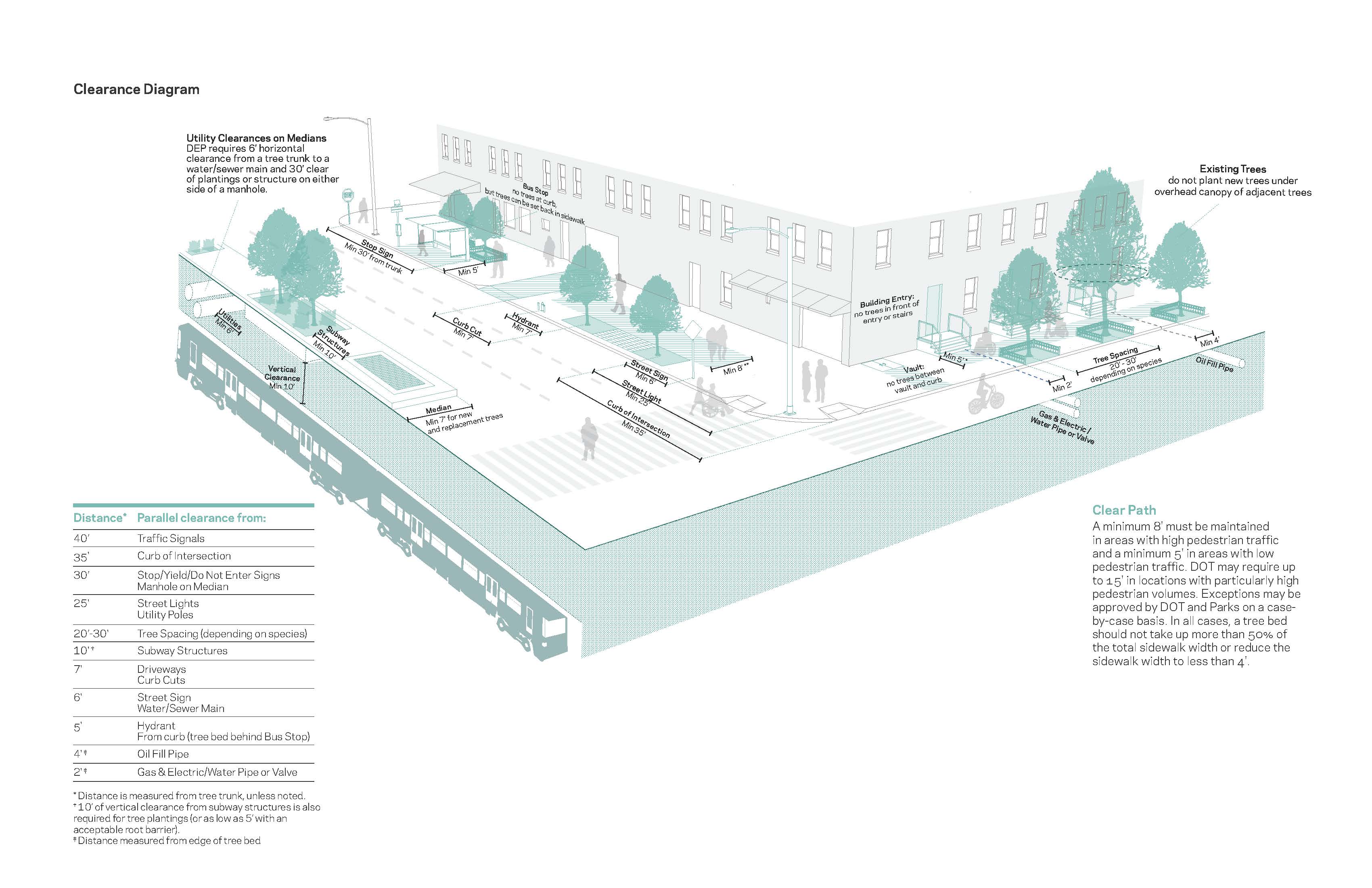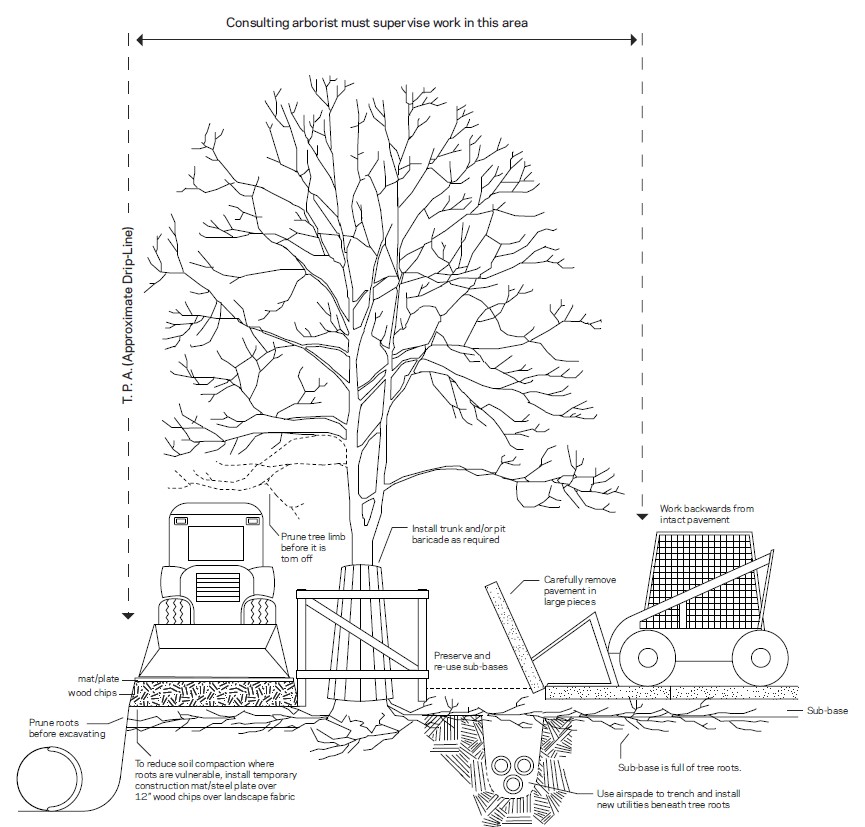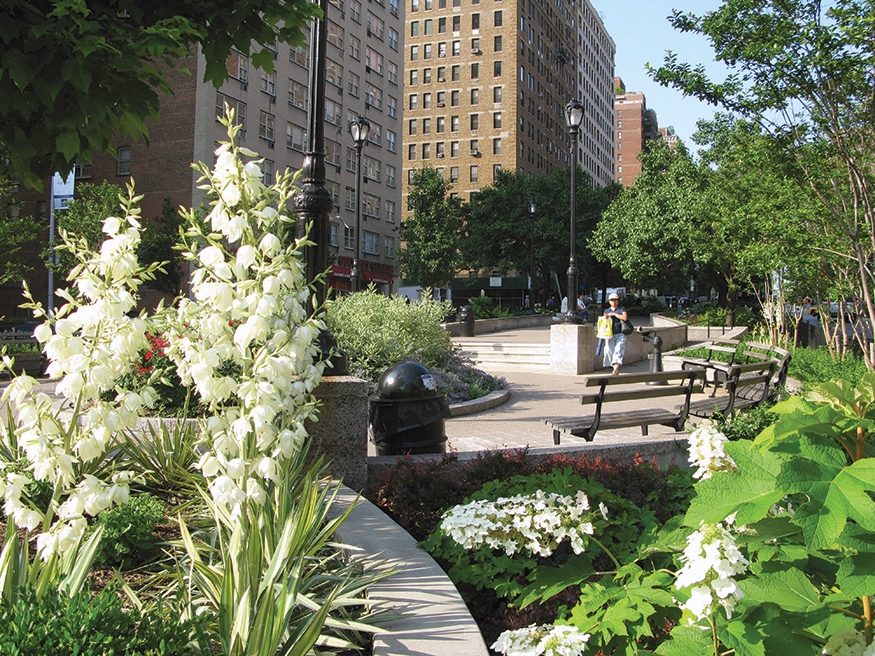
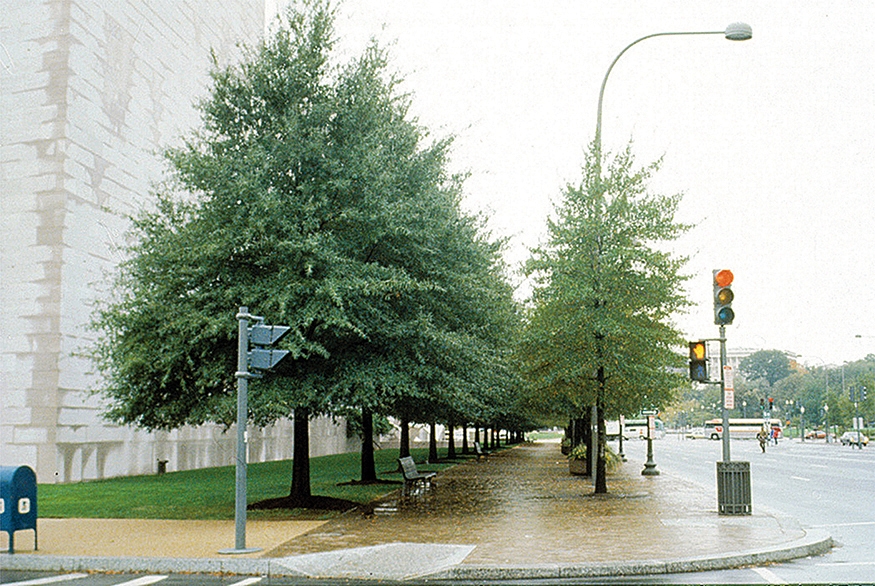
Reviews & Approvals
Installation of all plantings within the public ROW must be reviewed and approved by DOT and the agency that will be maintaining the plants. A tree work permit from Parks is required to install new trees and for any work being performed within 50 feet of existing trees. Proposed Stormwater Management Practices (also known as green infrastructure) within the public ROW must be reviewed and approved by DEP, Parks, and DOT. New plantings may be subject to PDC or LPC review, particularly if they are part of a streetscape or open space project within their purview.
Designs for planted areas and green infrastructure within the public ROW are still evolving and being tested. Because these treatments may ultimately be maintained by city agencies, the appropriate agencies must be consulted early in the design process so that all such treatments are technically viable and maintainable.
Maintenance Agreements
Parks is responsible for the maintenance of all trees within the public ROW and of Greenstreets, including select Stormwater Greenstreets. DEP maintains all stormwater management practices in the ROW that have been funded and approved by DEP. DOT maintains median plantings installed as part of Vision Zero Great Streets projects. Other plantings within the public ROW are encouraged but require coordination with appropriate agencies and a maintenance agreement with DOT.
For plantings requiring a maintenance agreement, proposals must be submitted to the appropriate DOT Borough Commissioner. Contact information for DOT Borough Commissioners can be found on the Contact DOT page or by calling 311.
Project Team
All projects that incorporate plantings should include appropriate team members such as a landscape architect, cconsulting arborist (CA), horticulturist, and/or soil specialist. These team members should be involved at the onset of the design process. Appropriate consultation with city and/or state agencies having jurisdiction should also occur early in the project.
Plant Selection
A successful planting design will match plants with existing site conditions and anticipated site use to achieve an aesthetically pleasing, functional, and long-lived landscape. Species selection must be guided by a comprehensive site analysis of the natural and built environment as well as the maintenance that plantings are anticipated to need and receive. Plant specification should follow DOT and Parks standards, including Local Law 11 of 2013, and, whenever possible, plants should be sourced from a nursery within 200 miles of the project site.
Attention should be given to plants’ color, form, foliage, and texture and how those elements can be combined to create year-round interest. Careful consideration should also be given to the forms and heights plants will reach at maturity and how they interact with other design elements, such as seating, signage, signals, and lighting as well as the built fabric including the sidewalk, roadway, and buildings. Avoid species that NYSDEC and/or Parks have determined to be invasive or that are susceptible to diseases and pests (see Diseases and Pests section on this page). Select plants that are known to compete well with invasive species; when feasible, preference should be given to native plantings that mimic plant communities in the native environment most reflective of the site context. Given site conditions, designers should accommodate the collection of stormwater where possible and select plants that can withstand both periodic inundation and drought. All species selection must be approved by the appropriate city agency during the review process.
Soils
Soils are one of the most crucial considerations when proposing plants within the ROW. Soils that possess favorable horticultural characteristics (pH, nutrients, drainage, soil texture, etc.) will allow the greatest array of plant species to thrive and reduce maintenance costs. These characteristics must be carefully considered and balanced in context of proposed species, plant tolerances, and overall project goals. Soils that do not support selected plant species, or alternatively, selecting species that do not thrive in a particular soil will have significant impacts on plant survivability and the overall success of a proposed landscape.
It is particularly important that enough soil volume is provided for the proposed planting; this measure contemplates depth as well as the total area of soil. Limited soil volume will stunt plant growth and contribute to plant decline or death. As such, maximize soil volume and choose plants that will grow well in the available soil volume. As most roots grow within the top layer of soil, increasing the soil surface area is most beneficial. However, also provide appropriate soil depth: at least 18 inches for grass or ground cover, 18-24 inches for shrubs, and 24-36 inches for trees. The soil depth should also relate to the rootball depth at planting.
Where pavement is necessary next to trees or plantings, consider a suspended pavement system (i.e. structural soils or structural framing systems/cells) to provide greater rooting area. Suspended pavement systems support the engineering requirements of pavement, while still allowing plant roots to grow in the subbase below. In most cases, pavements must be able to withstand typical loading and compaction requirements (95% proctor density), with some locations requiring truck loading (AASHTO HS-20) standards be met. The added growing medium can also serve to increase the area for stormwater capture or detention. Additionally, by encouraging root growth within the subbase, these systems typically reduce sidewalk heaving caused by tree roots and the associated maintenance burden.
In order to determine if an existing or proposed soil has the appropriate characteristics it must be examined by a qualified laboratory. Soils should be tested for texture, pH, organic content, permeability, salt content, nutrients, bulk density, and presence of contamination. New soils should meet appropriate DOT and Parks specifications, which may vary depending on project specific conditions. Existing soils may be amended to bring soil characteristics within acceptable ranges. Methods for amending soils include applying lime or sulfur to adjust pH, adding sand or silt/clay to adjust soil texture, adding organic matter to improve permeability and correct nutrient deficiencies, loosening compacted soil via mechanical or hand tools, and several other techniques. Qualified laboratories, following an examination, will provide recommendations for amending soils, if possible, to achieve optimal plant growth. If amendments cannot be made, the soil will need to be replaced to the required depth and width accordingly. Should there be contaminated soils on site, consult with the appropriate city or state agencies on the process for removal.
The following table describes generally desirable soil characteristics, however, soil must be examined and selected based on site-specific conditions and tailored to fit the needs of the project. It is important that proper sampling and testing methods are followed to ensure test results are accurate and represent the actual soil. A composite sample (taken from several locations within the area of interest, to a consistent depth, and at the same time) can provide an appropriate representative sample for testing purposes.
| Soil Characteristics | Preferred Range or Values | Testing Method |
|---|---|---|
| pH | 5.5 to 7.2 (slightly acidic soils generally have the greatest nutrient availability to plants; higher pH soils will require careful plant selection to ensure survivability) | Standard pH test |
| Organic Matter | 3-8% is generally preferred, but conditions may call for more or less organic matter | Loss on ignition of moisture-free samples (organic matter should be at least six months old) |
| Soil Texture | Sandy Loam to loam is typically preferred, but specific conditions may call for a higher clay content to increase water holding capacity or a higher sand content to facilitate infiltration; under no circumstances may clay content exceed 15-20% | Bouyoucos hydrometer or decantation method to determine clay content; USDA sieve analysis for sand and silt content Alt: ASTM D422 |
| Salinity | < 1.0 millimhos per centimeter at 25 degrees Celsius | Saturated Soil Test Method in USDA Circular No. 982 |
| Nutrients | Nitrogen = 25 parts per million Phosphorous = 5 parts per million Potassium = 20 parts per million |
Check with Soil Lab |
| Permeability | Appropriate permeability ranges depend on desired use. High permeability is generally required for green infrastructure systems, very low permeability will negatively impact plant health | Permeability Test (See DEP Geotechnical Investigation Procedure) |
| Bulk Density | Bulk density greater than 1.4 grams per cubic centimeter will restrict root growth and negatively impact plant health | ASTM D7263 |
Where possible, preserve existing soils that have supported or are capable of supporting plant growth. Care should be taken to manage existing weed seeds that are typically present in the top layer of urban soils; tarp stockpiled soil on site if it is to be reused later or if new soil is to sit idle for an extended time before being used. If time permits, techniques like solarization or steam sterilization can be employed to kill weeds. Do not work the soil if it is frozen or sodden. Use pneumatic excavation, or similar methods, under the supervision of a consulting arborist, to preserve tree roots. New soil should be installed in lifts so as to not unduly compact or negatively impact the soil properties. For new soil, it is important that appropriate sampling and testing is conducted prior to delivery as well as prior to installation to ensure quality soil is being provided; soil tests should not be older than 6 months from the date of proposed delivery to the project site. Ultimately, soils are the foundation for a successful landscape and must be given special attention to ensure success.
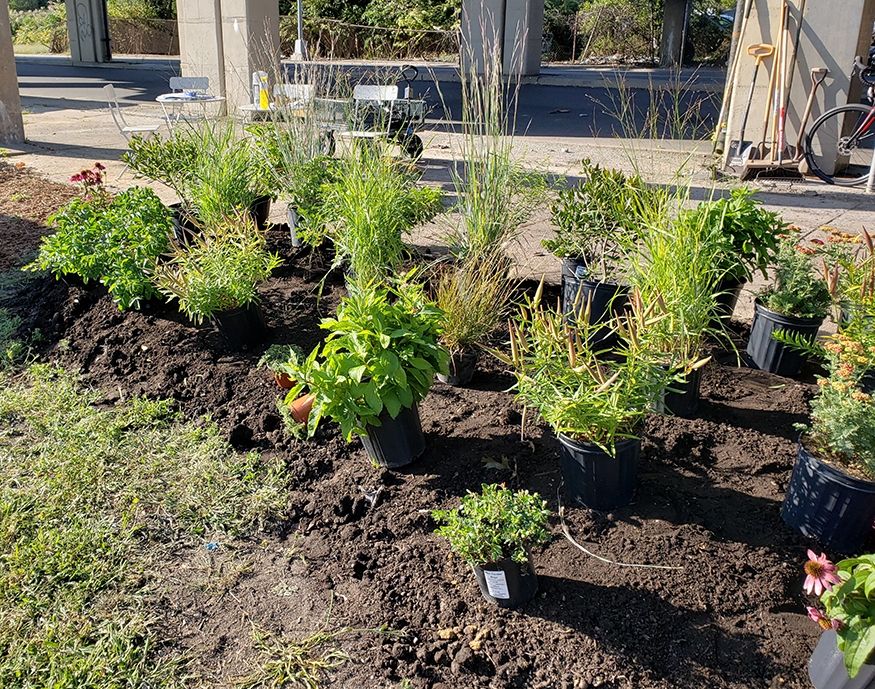
Quality soil is necessary to ensure that healthy plants thrive: Beach 60th Street and Rockaway Beach Boulevard, Queens
Microclimate
According to the 2012 USDA Hardiness Zone map, most of New York City falls within Zone 7B, with portions of the Bronx and Staten Island falling within Zone 7A. However, the site-specific environmental conditions such as sun exposure, wind patterns, and precipitation will ultimately create a unique growing environment for plants. This microclimate must be understood in order to select the most appropriate plants.
Recent trends of more extreme temperature and weather due to climate change will also impact plant selection. These trends will have a varied effect depending on the particular microclimate. For example, coastal areas have experienced temperatures consistent with Zone 6 over the last several winters, which may require hardier plants be specified.
Spacing/Siting Requirements
Landscape Clearance diagram [PDF]
See the Landscape Clearance diagram [PDF] for more information on siting requirements.
In the setting of streets, parkways, and expressways, the placement of trees and other plants has a direct bearing on safety and the cost of maintenance. Plants, excluding tree canopies, in the public ROW should not infringe upon the roadway or sidewalk beyond the planting bed. Ultimately, all plantings must follow MUTCD, AASHTO, NYSDOT, DEP, DCP, Parks, and DOT design standards and guidelines. (See Landscape Clearance diagram.)
Careful consideration must be given to above- and belowground constraints; utilities, vaults, and other obstructions may limit the ability to plant. In particular, avoid planting trees directly over DEP water and sewer mains and near steam lines.
Trees and other plantings must not block sight lines at intersections for drivers, cyclists, and pedestrians. At all intersections, trees and any plants that may impact sight lines must be placed no closer than 35 feet from the curb of the intersecting street and in a manner that does not block the signal or stop sign. Trees on medians must be set back 35 feet from the curb at the end of the median.
DOT, Parks and DEP may approve exceptions to their respective requirements on a case-by-case basis and reserve the right to require stricter clearances if needed.
Tree Preservation and Protection
Mature trees must be preserved during construction wherever feasible because they provide significantly more benefits compared to newly planted replacement trees. Such preservation can be complicated and should therefore be guided by a consulting arborist (CA) throughout the project. The following provides general information on how best to approach design with the preservation of existing trees in mind.
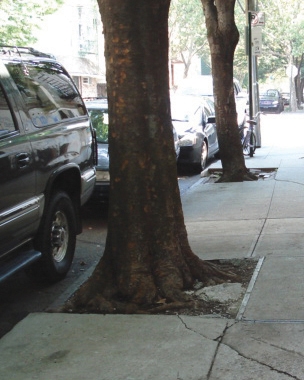
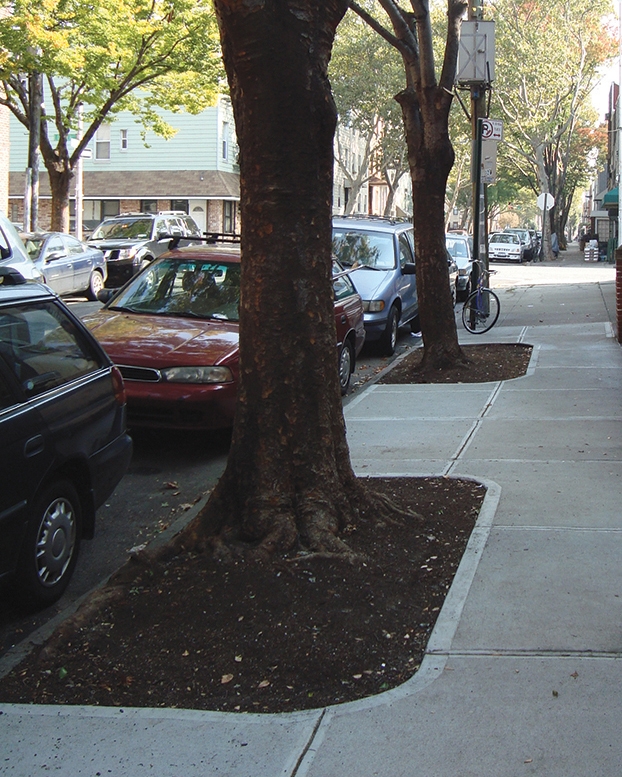
Parks is expanding existing tree beds throughout the city to promote tree health and reduce potential trip hazards created by heaving: Devoe Street, Brooklyn (Credit: Parks)
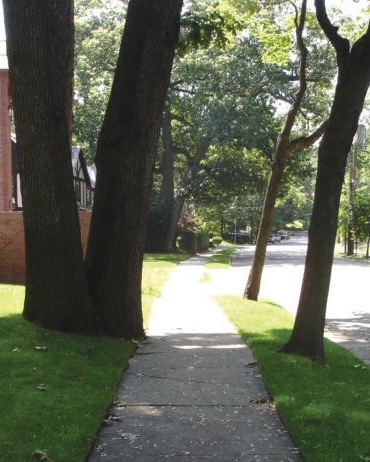
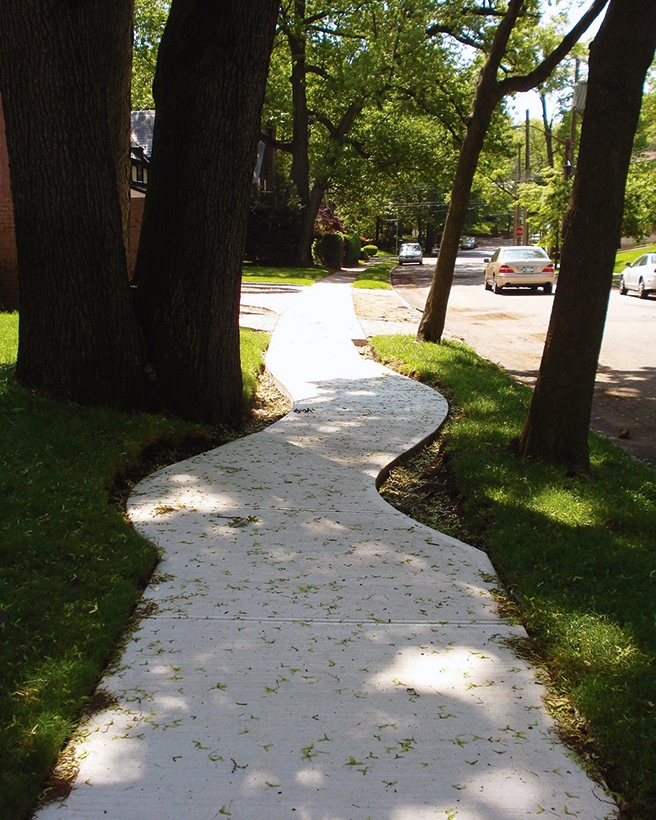
Reconfiguration of a sidewalk to promote tree health (before and after): Aberdeen Road, Queens (Credit: Parks)
Under Section 18-107 of the Administrative Code of the City of New York and Chapter 5 of Title 56 of the Rules and Regulations of the City of New York, all construction work impacting trees within the public ROW must be approved and permitted by Parks. In addition, construction work must follow NYC Parks Tree Preservation Protocols and NYC Parks Forestry Protocol for Planned and Emergency Utility Work. Ultimately, if the removal of a healthy tree is necessary, it must be approved and permitted by Parks, and tree replacement will be required based on a valuation of the trees impacted. This typically involves planting new trees within the project area and/or paying a fee to cover the cost of Parks planting the necessary replacement trees.
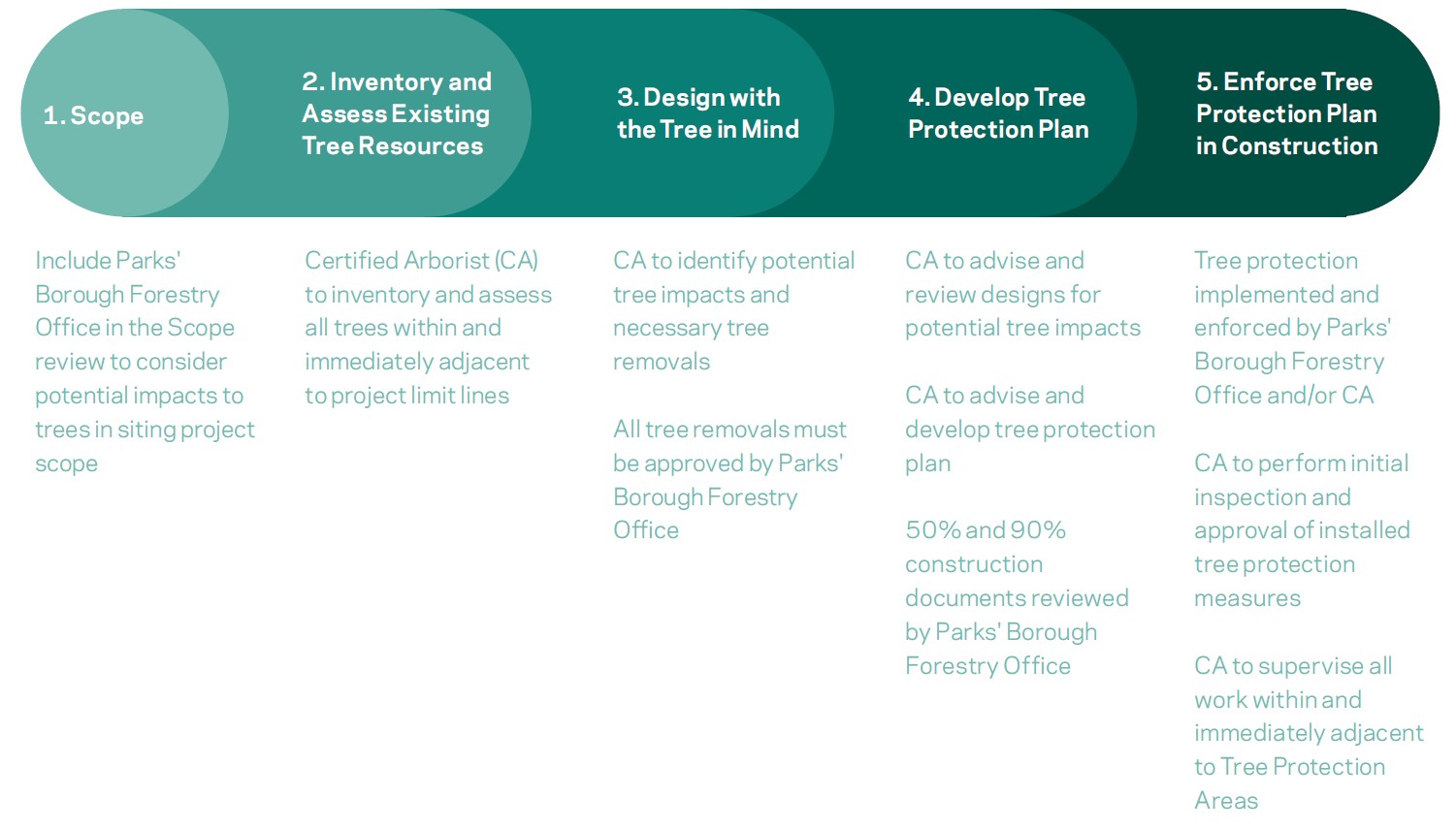
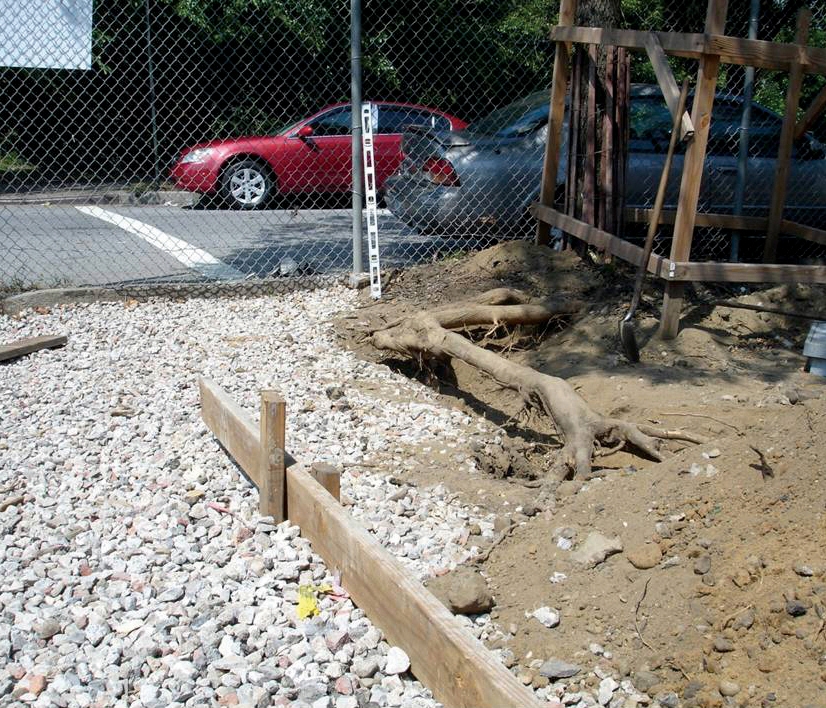
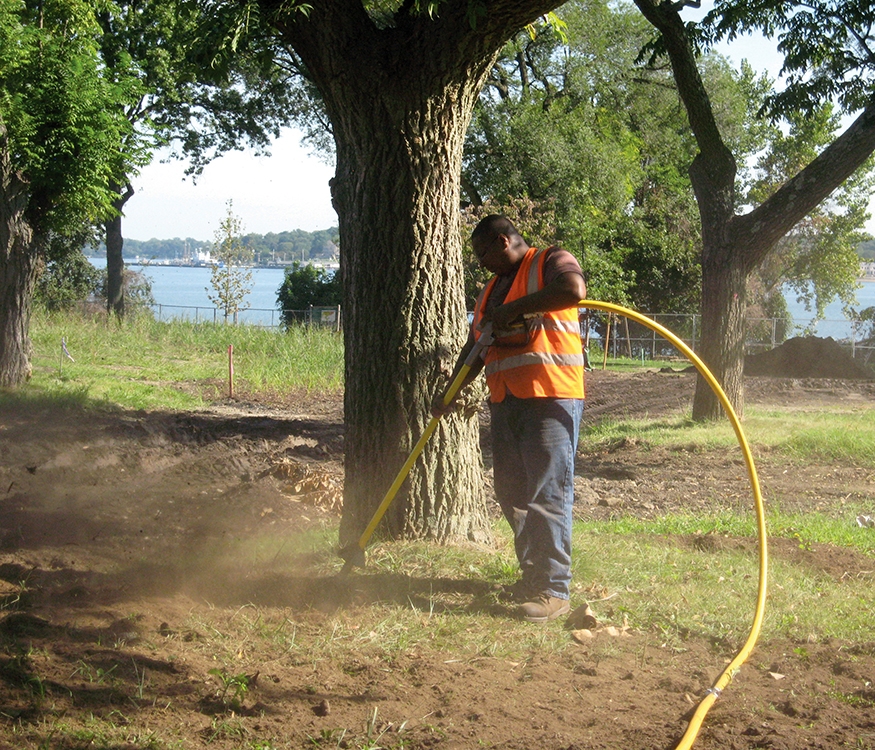
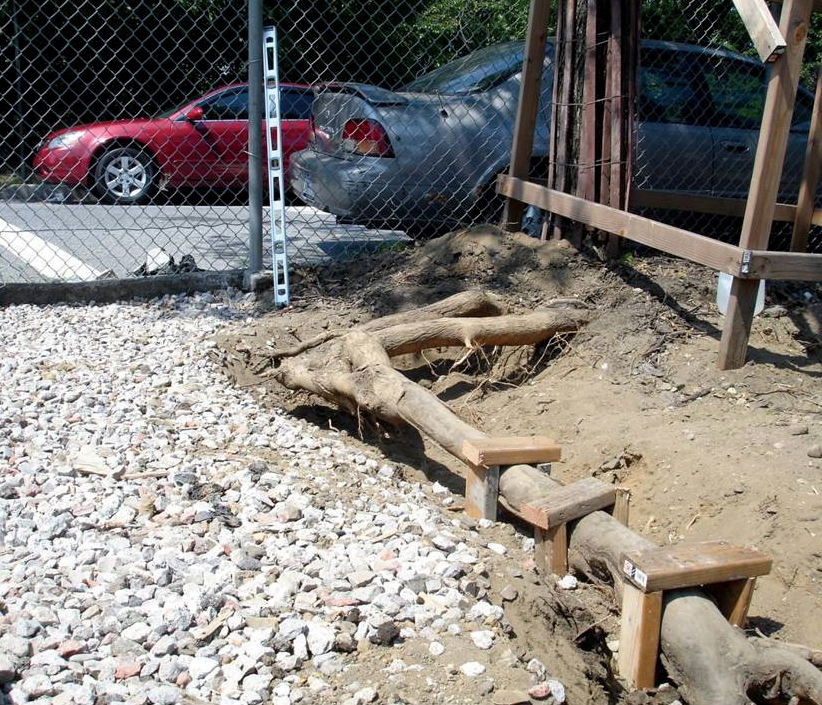
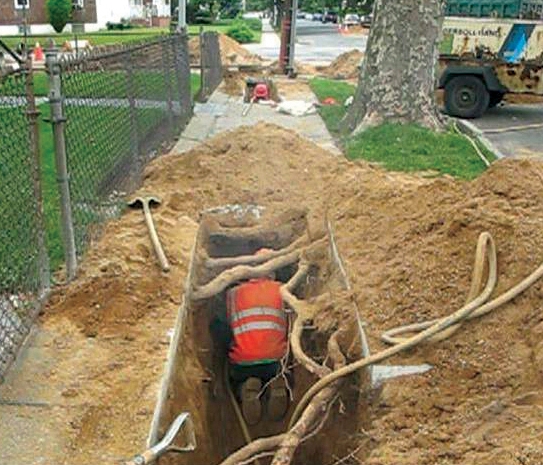
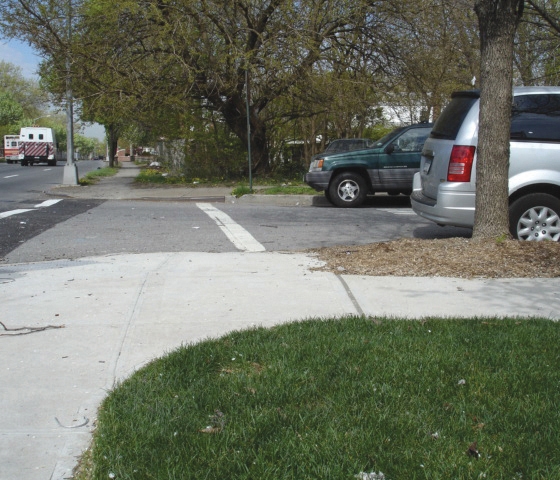
Removing soil from around a tree’s roots through pneumatic excavation allows for work to be done without damaging the tree: ABOVE – Fort Totten Park, Queens (Credit: Parks); BELOW – 235th Street and 119th Avenue, Queens (Credit: Lisa Montana)
The above photos illustrate the process of root pinning, which saves trees and prevents sidewalk heaving: Black Locust Triangle, 123rd Street and N Conduit Avenue, Brooklyn (Credit: Parks)
In order to preserve existing trees, their roots must be protected. Tree roots extend well beyond the visible canopy and are generally within the top three feet of soil. The minimum area of roots a tree needs to survive is called the critical root zone (CRZ) and will be determined by the CA using the International Society of Arboriculture’s Best Management Practices for Managing Trees During Construction (F. Kite, T. Smiley, 2008). The individual CRZ radii should be incorporated into all phases of design and reflected on a CRZ map. The goal is to preserve as many roots as possible beyond the CRZ through sensitive design and the use of best practices during construction.
Tree Protection Area diagram and Critical Root Zone diagram [PDF]
The Tree Protection Area diagram and Critical Root Zone diagram [PDF] provide guidance on tree protection during construction projects in an urban setting.
The tree protection area (TPA) is the most important tool used in the preservation of existing trees. Generally, the TPA is developed in coordination with the CA during design and is defined by the canopy drip line of the tree. The TPA will always encompass the CRZ. (See Tree Protection Area Diagram and Critical Root Zone Diagram above). During construction, the TPA is typically established with a fence or barrier, with installation of thick sawdust, plywood sheets or metal panels beyond the barrier, if necessary, to further protect spreading roots. In circumstances where a majority of roots are growing beneath pavement, special methods should be utilized. The contractor will be responsible for the care of protected trees during construction. No activity, including non-construction related activities, may occur within the TPA without approval from Parks and supervision by the CA. If construction work must occur within the TPA, the contractor must work with the CA to employ techniques, such as pneumatic excavation (air spading) to expose and preserve the roots in good condition. All work within the TPA must be completed by hand.
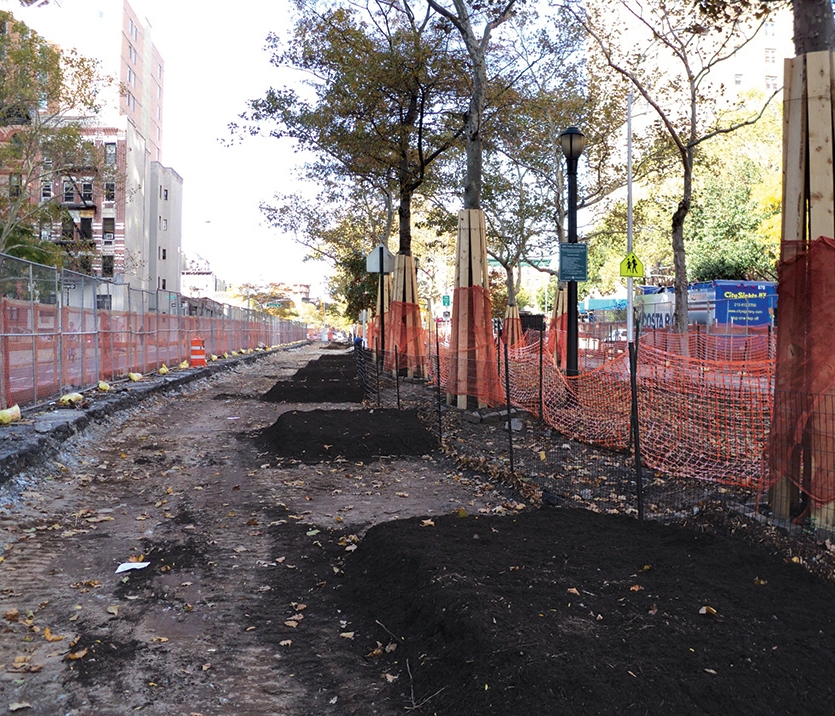
Tree protection measures during reconstruction of the Allen Street Malls, Manhattan (Credit: Parks)
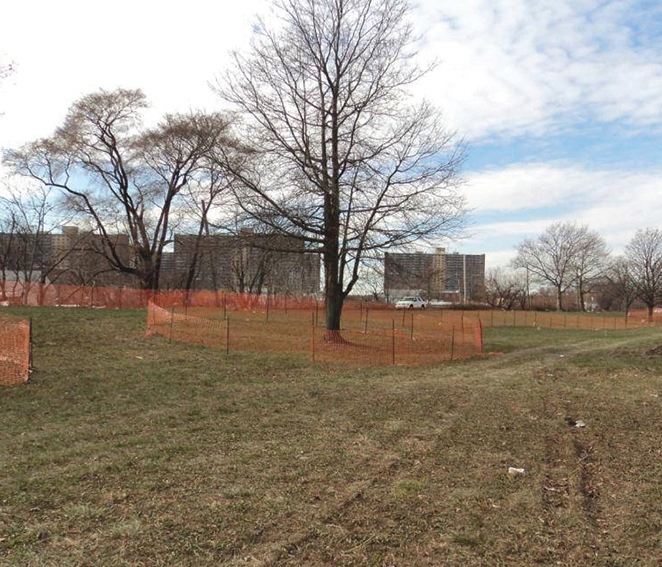
Typical tree protection area (TPA) in a landscape setting; specialized treatments should be used in urban settings: Conduit Avenue, Queens
Diseases and Pests
Diseases and pests can pose significant risks to plant health and survival. Plants should be selected that are resistant to common ailments, such as anthracnose (leaf spot), or that can withstand outbreaks.
Several pests affect trees in New York City. ALB (Anoplophora glabripennis) is an invasive beetle known to attack several species of trees. After 20 years of efforts to eradicate the beetle, New York City was declared ALB-free by the United States Department of Agriculture (USDA) in October 2019. For more information, visit the USDA’s Animal and Plant Health Inspection Service webpage or the USDA’s APHIS publication regarding ALB in New York.
EAB (Agrilus planipennis) is an invasive beetle that is destroying ash populations across the Northeast and Midwest. As such, the planting of ash tree species is no longer permitted within the city.
NYSDEC and Cornell University both offer plant disease diagnostic services that may assist in the treatment of affected plants. For the latest information on diseases and pests please visit the UDSA’s APHIS webpage on Plant Pest and Disease Programs or the US Forest Services webpage on Invasive Species, Pests, and Disease.
Application of pesticides (including herbicides, insecticides, and fungicides) is regulated by the federal EPA as well as NYSDEC. Pesticides may only be applied by a NYSDEC Certified Commercial Pesticide Applicator or under the direct supervision of same. Additionally, pesticides applied to property owned or leased by the city must comply with Chapter 12 of Title 17 of the Administrative Code of the City of New York (Local Law 37 of 2005). Note that this law does not apply to private property. For more information on this law, visit the DOHMH webpage or call 311.
Plant Installation
All plants must be installed per DOT and/or Parks standards. See Parks’ Planting Specification Checklist. In addition, contact DigNet or call 811 prior to installation to identify utilities and have them field-verified by proper authorities. The appropriate planting time for trees, shrubs, and perennials is during the spring and fall, with some trees restricted to spring planting only. In New York City, this corresponds generally to March 1–May 31, and October 1–December 31, weather permitting. No plants should be installed in the summer or once the ground has frozen.
Period of Establishment
Newly installed plants require consistent maintenance throughout the growing season in order to become established and thrive. As per DOT/DDC standard specifications, the contractor will need to perform establishment period tasks, including but not limited to, watering, pruning, mulching, and weeding, throughout the first 18 months for understory plantings and 24 months for trees. Watering is the most essential task to perform during the establishment period (see Watering section on this page). Payment for the performance of these tasks is on a progress payment schedule whereby the contractor will only be paid when they perform the required tasks. Parks planting permits also require the contractor to water, perform regular care, and replace trees that die for the first two years. A maintenance plan should be submitted and approved prior to final acceptance of plant installation, after which the Period of Establishment will commence.
Maintenance
Site design and species selection should correspond to the anticipated level of maintenance a planting will receive following installation. Planting areas should be designed to provide sufficient space for personnel to maintain them. Such design considerations may include, among other things, paths within or surrounding the planting areas. The frequency of available maintenance and skill levels of those providing maintenance are important considerations that must be addressed during design.
Maintenance should include an appropriate level of watering, weeding, pruning, cultivating, and waste removal. Repair of minor washouts, mulching, soil replacement, plant replacement and other horticultural operations may also be necessary. Stormwater Management Practices will have additional unique maintenance tasks necessary to maintain their function. Any existing invasive plants that cannot be removed or outbreaks of new invasive species will have to be managed through ongoing maintenance. Selecting plants that are drought tolerant, are disease resistant, compete well, and have the appropriate form at maturity will reduce maintenance needs.
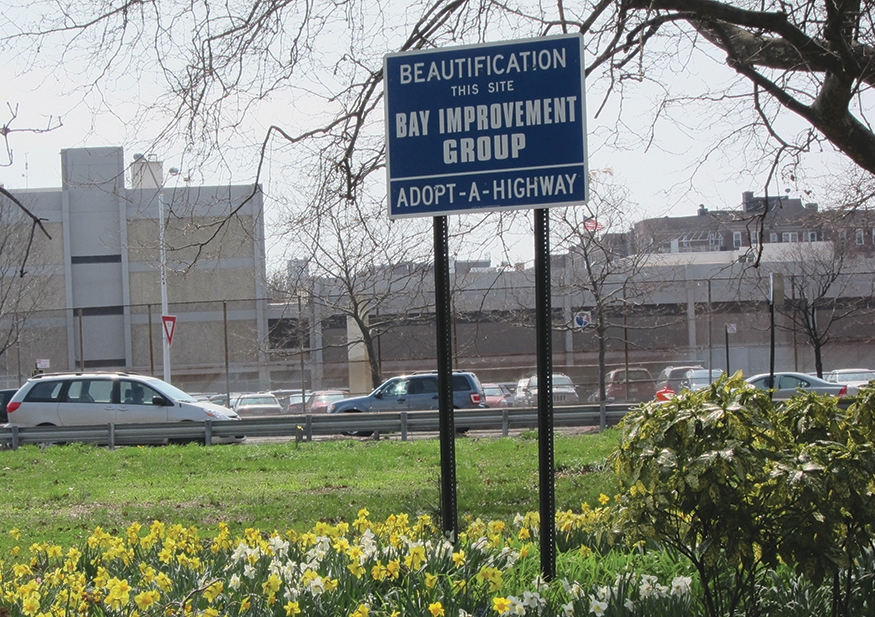
DOT’s Adopt-a-Highway program provides opportunities for enhanced plantings and maintenance along limited-access arterials: Belt Parkway, Brooklyn
Watering
Watering is critical for plant survival, both during the establishment period and throughout the lifespan of the plant. Ideally, water should be applied early in the morning or late at night to avoid loss due to evaporation. The soil should be thoroughly soaked with minimal water applied to the leaves of plants as this may encourage fungus or disease. Do not overwater. In New York City, it is recommended plants receive approximately 1 inch of water per week in total, species and weather dependent. Tree watering bags provide an effective tool during establishment and should be refilled to ensure trees receive approximately 20 gallons of water per week. Watering must be carefully scheduled and adjusted based on anticipated and actual weather.
Irrigation systems are encouraged where appropriate maintenance of the system can be provided. The system, when properly maintained, can reduce the need for maintenance by ensuring the most frequently required task is automated. Newer systems also provide remote monitoring and scheduling, automatic weather adjustment, and maintenance notifications if the system needs repair. Design of the system is paramount; systems should not spray water onto the roadway or walking areas. Drip irrigation is most efficient, but prone to damage and breaks. Pop-up/spray heads may be preferred as long as they can be directed appropriately. In many cases, even if a full irrigation system cannot be accommodated, simply bringing a water source via a hose-bib connection will significantly reduce maintenance costs. All irrigation systems require yearly winterization and start-up maintenance. They also require appropriate backflow prevention, typically a reduced pressure zone or “RPZ” backflow device, and a water meter, which must be approved by DEP. The RPZ and meter will need to be carefully sited within the project area to minimize visual impact as they are large and obtrusive. Providing an irrigation system or water source will impact plant selection allowing a wider range of plants to be used, but only if maintenance for the irrigation system is also in place.


